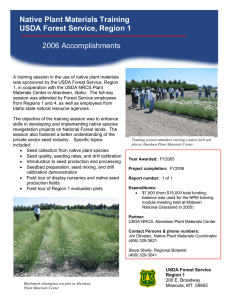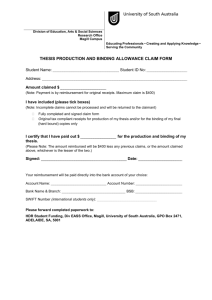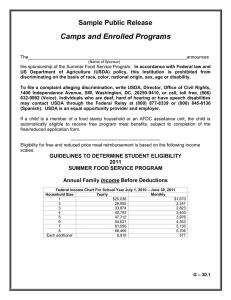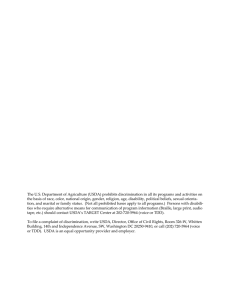Chamaebatia foliolosa bearmat Rosaceae—Rose family
advertisement
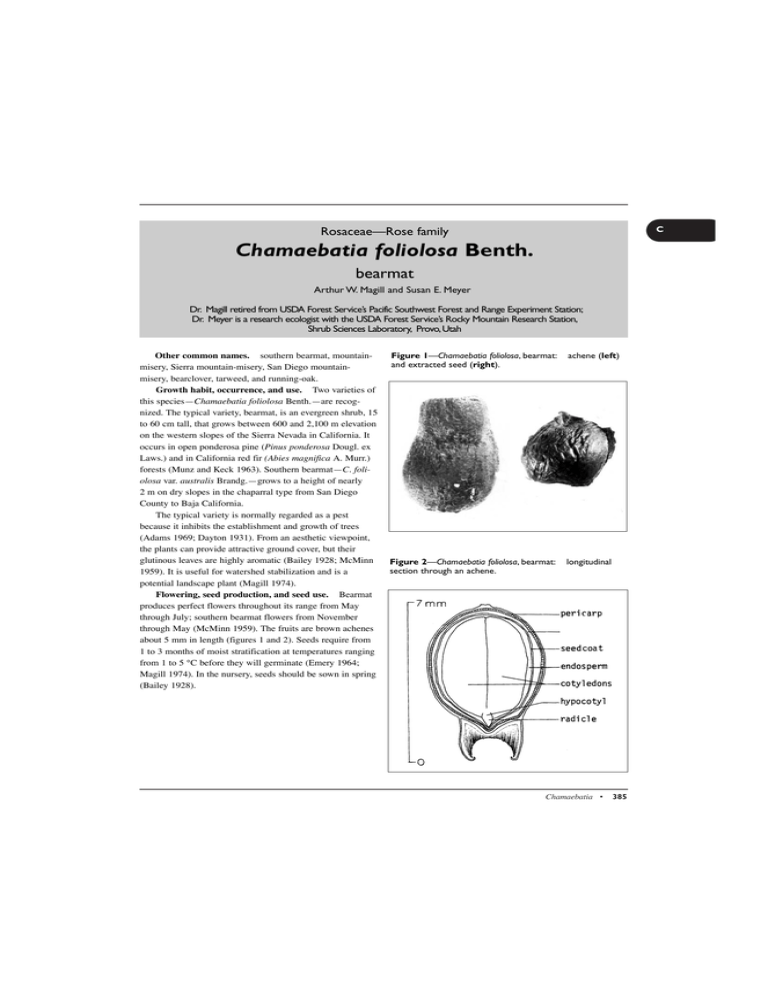
C Rosaceae—Rose family Chamaebatia foliolosa Benth. bearmat Arthur W. Magill and Susan E. Meyer Dr. Magill retired from USDA Forest Service’s Pacific Southwest Forest and Range Experiment Station; Dr. Meyer is a research ecologist with the USDA Forest Service’s Rocky Mountain Research Station, Shrub Sciences Laboratory, Provo, Utah Other common names. southern bearmat, mountainmisery, Sierra mountain-misery, San Diego mountainmisery, bearclover, tarweed, and running-oak. Growth habit, occurrence, and use. Two varieties of this species—Chamaebatia foliolosa Benth.—are recognized. The typical variety, bearmat, is an evergreen shrub, 15 to 60 cm tall, that grows between 600 and 2,100 m elevation on the western slopes of the Sierra Nevada in California. It occurs in open ponderosa pine (Pinus ponderosa Dougl. ex Laws.) and in California red fir (Abies magnifica A. Murr.) forests (Munz and Keck 1963). Southern bearmat—C. foliolosa var. australis Brandg.—grows to a height of nearly 2 m on dry slopes in the chaparral type from San Diego County to Baja California. The typical variety is normally regarded as a pest because it inhibits the establishment and growth of trees (Adams 1969; Dayton 1931). From an aesthetic viewpoint, the plants can provide attractive ground cover, but their glutinous leaves are highly aromatic (Bailey 1928; McMinn 1959). It is useful for watershed stabilization and is a potential landscape plant (Magill 1974). Flowering, seed production, and seed use. Bearmat produces perfect flowers throughout its range from May through July; southern bearmat flowers from November through May (McMinn 1959). The fruits are brown achenes about 5 mm in length (figures 1 and 2). Seeds require from 1 to 3 months of moist stratification at temperatures ranging from 1 to 5 °C before they will germinate (Emery 1964; Magill 1974). In the nursery, seeds should be sown in spring (Bailey 1928). Figure 1—Chamaebatia foliolosa, bearmat: and extracted seed (right). achene (left) Figure 2—Chamaebatia foliolosa, bearmat: section through an achene. longitudinal Chamaebatia • 385 C References Adams RS. 1969. How to cure mountain misery. Sacramento: California Division of Forestry. 23 p. Bailey LH. 1928. The standard cyclopedia for horticulture. New York: Macmillan. 3639 p. Dayton WA. 1931. Important western browse plants. Misc. Pub. 101. Washington, DC: USDA. 214 p. Emery D. 1964. Seed propagation of native California plants. Santa Barbara Botanical Garden Leaflet 1(10): 81–96. 386 • Woody Plant Seed Manual McMinn HE. 1959. An illustrated manual of California shrubs. Berkeley: University of California Press. 663 p. Magill AW. 1974. Chamaebatia foliolosa Benth., bearmat. In: Schopmeyer CS, tech. coord. Seeds of woody plants in the United States. Agric. Handbk. 450. Washington, DC: USDA Forest Service: 315. Munz PA, Keck DD. 1963. A California flora. Berkeley: University of California Press. 1681 p.
